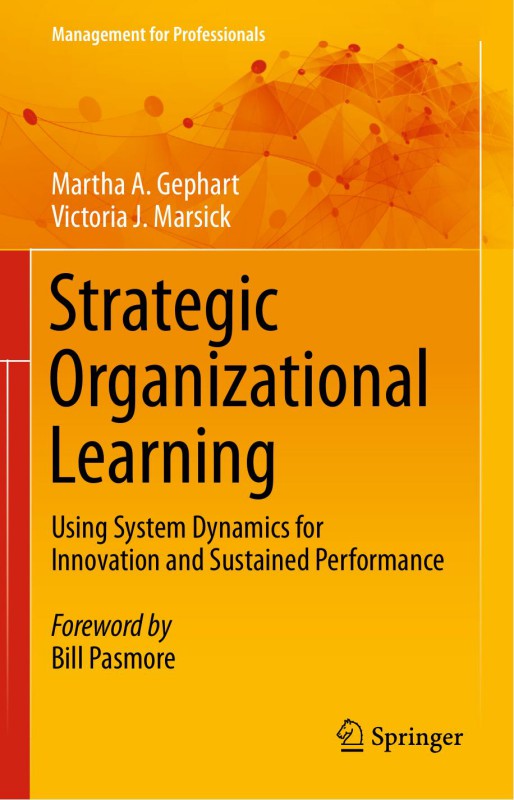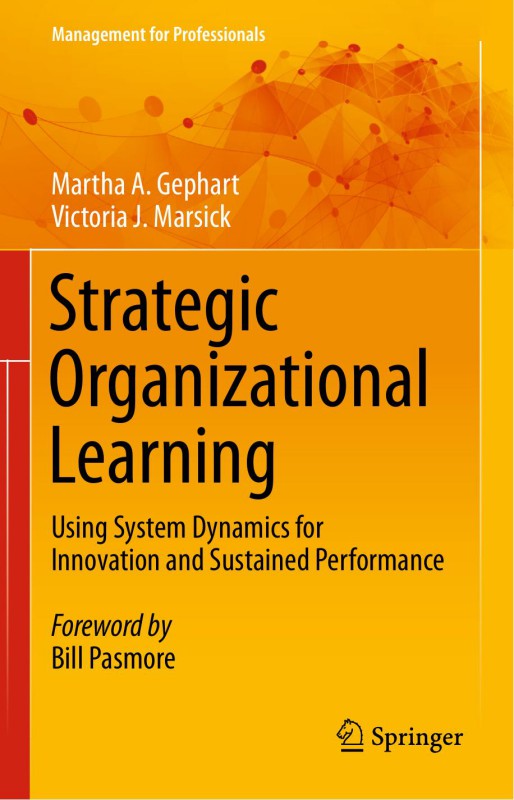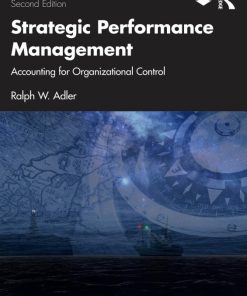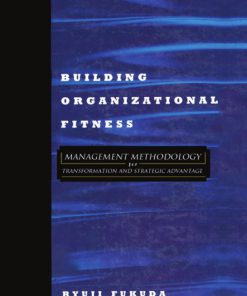Strategic Organizational Learning Using System Dynamics for Innovation And Sustained Performance 1st Edition by Martha Gephart, Victoria Marsick 3662486415 9783662486412
$50.00 Original price was: $50.00.$25.00Current price is: $25.00.
Authors:Martha A. Gephart, Victoria J. Marsick (auth.) , Series:Strategic Studies [17] , Author sort:Martha A. Gephart, Victoria J. Marsick (auth.) , Languages:Languages:eng , Published:Published:Nov 2015 , Publisher:Springer
Strategic Organizational Learning Using System Dynamics for Innovation And Sustained Performance 1st Edition by Martha Gephart, Victoria Marsick – Ebook PDF Instant Download/Delivery. 3662486415, 9783662486412
Full download Strategic Organizational Learning Using System Dynamics for Innovation And Sustained Performance 1st Edition after payment

Product details:
ISBN 10: 3662486415
ISBN 13: 9783662486412
Author: Martha A. Gephart, Victoria J. Marsick
This book discusses the successes and challenges of leveraging organizational learning in effective strategy development and execution. The authors introduce a framework that helps organizations develop core capabilities to enable them to shift direction rapidly and proactively shape future environments. They also offer a wide selection of cases to illustrate this framework. While some cases highlight fundamental strategic change over time, others are snapshots of mechanisms gradually put in place to jointly optimize learning and performance. There is no one best or right way to leverage strategic organizational learning; different practices may lead to the same outcome and similar practices may lead to different outcomes. The system dynamics underlying such learning — not the simple adoption of one or other practice — are key to success in institutionalizing a performance-based learning approach.
Strategic Organizational Learning Using System Dynamics for Innovation And Sustained Performance 1st Table of contents:
1: Introduction
1.1 Overview
1.2 Introducing Our Model
1.3 In-Depth Cases of System Learning and Change
1.3.1 Engineered Woods
1.3.2 Happy Land Amusement Park
1.3.3 South Side High School
1.3.4 Ericsson
1.3.5 Autism Model Program
1.3.6 CASAWORKS for Families
1.4 Implications for Strategic Organizational Learning
2: Strategic Leverage Through Learning
2.1 Overview
2.1.1 Changes at the System Level
2.2 Foundations of Our Model: Strategic Leverage Through Learning
2.3 Use of Our Model in a Federal Judicial Agency
2.3.1 Challenges Following Innovation
2.3.1.1 Challenges in Outcomes
2.3.1.2 Transformational Barriers
2.3.1.3 Transactional Barriers
2.3.2 Assessment and Intervention
2.3.3 Improved Results
2.4 Our Model: A Learning Approach to Change
2.4.1 A Learning Approach to Change
2.4.2 This Book
References
3: Engineered Woods
3.1 Overview
3.2 Act I: Committing to a Vision Focused on a Risky, Breakthrough Strategy
3.2.1 A Bold Stretch Goal Amidst Much Skepticism
3.2.2 The Challenge: Developing Organizational Capacity for Productization
3.3 Act II: Learning to Develop Specialty Products
3.3.1 New Structures and Mechanisms to Bring the Right People Together
3.3.2 Learning to Use, and Modify, a Stage-Gate Product Development Process
3.3.3 Training to Support Team Work
3.3.4 Building on Lessons Learned
3.4 Act III: Learning to Market and Sell Specialty Products
3.4.1 Hiring and Learning from Consumer Marketing Talent
3.4.2 Discovering Builders and How to Market to Them
3.4.3 New Marketing Approaches Led to New Sales Approaches
3.5 Act IV: Learning to Manufacture Specialty Products
3.6 Act V: Developing a Culture and Systems that Support Innovation
3.6.1 Changing Leadership at the Top
3.6.2 A Culture of Innovation
3.6.3 Systems and Processes
3.7 Act VI: Sustaining the Revolution
3.7.1 Company´s Strategy and Market Position
3.7.2 Organizational Learning and Knowledge Sharing
3.7.3 Supporting Systems, Staff, Structure, Culture
3.8 System Dynamics: Our Model
References
4: Happy Land Amusement Park
4.1 Overview
4.1.1 The Amusement Park
4.1.2 Park Leadership
4.2 Phase 1: Learning from a Fatality
4.2.1 Framing or Blaming
4.2.2 Building Alignment
4.2.3 Framing New Policies
4.2.4 Monitoring Performance
4.2.5 Reframing
4.3 Phase Two: A Deeper Dive
4.3.1 Diagnosing the Larger Problem
4.3.2 Building a Shared Vision
4.3.3 Sharing the Vision
4.3.4 Taking Time for Reflection
4.4 Phase Three: Tragedy Strikes Again
4.4.1 Framing and Reframing
4.4.2 Putting New Safety Mechanisms in Place
4.4.3 Modeling Safety Behaviors
4.5 Phase Four: Safety Becomes Personal
4.5.1 Reorganizing to Maintain Safety
4.5.2 Detecting and Correcting Safety Errors
4.6 Summing Up
4.7 System Dynamics: Our Model
References
5: Leveling Up: How South Side High School Learned to Transform Itself
5.1 Overview
5.1.1 A Visionary Impetus
5.1.2 Need to Change
5.2 The Context: Rockville Centre and Tracking
5.3 Raising Expectations: Increasing the Regents Diploma Rate
5.3.1 Getting Started
5.3.2 Guidance Counselors Were Key
5.3.3 Structural Changes
5.3.4 Heterogeneous Classes
5.3.5 Beating the Goal
5.4 Greater Expectations: Expanding the IB Program
5.4.1 Bringing Students on Board
5.4.2 Changing How Teachers Teach
5.4.2.1 Sharing Data and Results with Teachers
5.4.2.2 Getting Data from Teachers
5.4.2.3 Developing Teachers I
5.4.2.4 Developing Teachers II
5.4.2.5 Maintaining the Faculty
5.4.3 Sharing Data Outside the School
5.4.4 Attaining Even More Success
5.5 Summing Up
5.6 System Dynamics
References
6: Linking Leadership Development to Strategy at Ericsson
6.1 Overview
6.2 Assessing Changes in Executive Education
6.2.1 What the New Program Looked Like
6.2.2 A Critical Convergence
6.2.3 Huber Institute´s Assessment of Fifth Custom Program
6.3 How the Program Made a Difference
6.3.1 Strategy Development and Implementation
6.3.2 Personal and Leadership Development
6.4 How Participants Used What They Learned
6.4.1 Adapting the Strategy Cycle to Business Unit Needs
6.4.1.1 Developing Locally-Held Situation Analysis Strategy Workshops
6.4.2 Developing Competence and Micro-Strategies for Operational Efficiencies
6.4.3 Capitalizing on Outside-In Thinking
6.4.3.1 Bringing in Fresh Perspectives
6.4.3.2 Networking and Partnering to Sell Services
6.4.3.3 Helping the Whole Office Learn Service Work
6.5 How Leaders Engaged Organizational Learning
6.5.1 Building a Critical Mass
6.5.2 Changing the Way the Organization Works
6.5.3 Sharing Knowledge Across Boundaries
6.6 Catalyzing Effect of Networks
6.7 Organizational Supports for and Barriers to Strategy Work
6.8 Summing Up
6.9 System Dynamics: Our Model
References
7: How Schools Learn to Collaborate and Change Their Cultures by Implementing an Autism Model Progra
7.1 Overview
7.2 The AMP Model
7.2.1 Team Teaching in the Classrooms
7.2.2 Transdisciplinary Collaboration
7.2.2.1 Social Development Intervention
7.2.2.2 Collaboration Within the Network
7.2.2.3 Team Meetings
7.3 The Schools
7.4 How Washington Elementary Learned to Implement AMP
7.4.1 Leadership
7.4.2 Team Meetings
7.4.3 Collaborative Relationships
7.4.4 Informal Support
7.4.5 Outside Observations
7.4.6 Knowledge Transfer Within and Across Schools
7.4.7 Parent-School Relationships
7.5 How Lincoln Elementary Learned to Implement AMP
7.5.1 Leadership
7.5.2 Collaborative Team Teaching
7.5.3 Informal Support
7.5.4 Team Meetings
7.5.5 Outside Observations
7.5.6 Knowledge Transfer Within and Across Schools
7.5.7 Parent-School Relationships
7.6 Common Principles: Tailored Practice
7.6.1 Shared Leadership
7.6.2 Collaborative Team Teaching
7.6.3 Informal Support
7.6.4 Team Meetings
7.6.5 Knowledge Transfer Within Schools
7.6.6 Knowledge Transfer Across Schools
7.6.7 Parent-School Relationships
7.6.8 Climate and Culture
7.7 Summing Up
7.8 System Dynamics: Our Model
References
8: CASAWORKS for Families
8.1 Overview
8.1.1 Assessment of Organizational Capacity and Learning for Collaboration and Service Delivery
8.2 Capacities that Sites Needed to Develop
8.3 Successful Sites
8.3.1 Site A
8.3.2 Site B
8.3.3 Site C
8.4 Capacities of the Successful Sites
8.4.1 Problems and Adequacy of Services in Place
8.4.1.1 Site A
8.4.1.2 Site B
8.4.1.3 Site C
8.4.2 Integrated Service Delivery
8.4.3 Effective Partner Collaboration
8.4.4 The CASAWORKS Organization/Staff
8.5 How Successful Sites Developed Needed Capacities
8.5.1 Site A
8.5.2 Site B
8.5.3 Site C
8.6 Unsuccessful Sites
8.6.1 Site D
8.6.2 Site E
8.6.3 Site F
8.6.4 Factors Contributing to Lack of Success in Sites
8.7 How the Sites Did
8.7.1 What Predicted Client Outcomes
8.8 How Sites Achieved These Outcomes
8.8.1 Effective Service Delivery
8.8.2 Effective Collaboration Among Partners
8.8.3 Organizational Learning
8.8.4 Organizational Capacity
8.9 System Dynamics: Our Model
References
9: Leveraging System Dynamics for Strategic Learning
9.1 Overview
9.2 Spotlight on System Dynamics
9.2.1 System Dynamics in the Engineered Woods Case
9.2.2 System Dynamics in the Happy Land Amusement Park Case
9.2.3 System Dynamics in the South Side High School Case
9.2.4 System Dynamics in Ericsson
9.2.5 System Dynamics in AMP
9.2.6 System Dynamics in CASAWORKS
9.3 System Dynamics Patterns
9.3.1 Direction of Flow When Initiated at the Transformational System Level
9.3.2 Direction of Flow When Initiated at the Transactional System Level
9.4 Cross-Case Dynamics
9.5 Insights from Research and Practice
References
10: Using Strategic Leverage Through Learning to Address Organizational Challenges
10.1 Overview
10.2 Using Our Model to Get Better Results
10.2.1 Customized Surveys to Design and Support Interventions
10.2.2 Understanding What Works and How It Can Be Improved
10.2.2.1 Ericsson and the Columbia Business School, Executive Education
10.2.2.2 U.S. Army
10.2.3 Lessons Learned from Successful Interventions
10.3 Using Strategic Leverage Through Learning
10.4 Variations in Using Our Model
10.4.1 Guiding New Interventions
10.4.2 Assessing and Improving Existing Interventions
10.4.3 Exploring New Opportunities
10.4.4 Using Our Off-the-Shelf Assessment Tool
10.5 Embarking on a Learning Approach to Change
People also search for Strategic Organizational Learning Using System Dynamics for Innovation And Sustained Performance 1st:
strategic leadership and organizational learning
strategic systems leadership
organizational learning strategy example
strategic organizational learning












